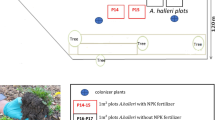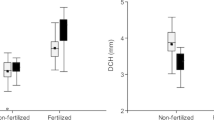Abstract
Although successful cultivation of the black truffle (Tuber melanosporum) has inspired the establishment of widespread truffle orchards in agricultural lands throughout the world, there are many unknowns involved in proper management of orchards during the 6–10 years prior to truffle production, and there are conflicting results reported for fertilizer treatments. Here, we systematically evaluate the combined effects of nitrogen, phosphorous, and potassium with different doses of each element, applied to either foliage or roots, on plant growth parameters and the mycorrhizal status of outplanted 3-year-old seedlings in five experimental Quercus ilex–T. melanosporum orchards. Fertilization did not significantly improve seedling aboveground growth, but the plants treated with the fertilizer 12-7-7 applied to the roots (HNr) displayed longer field-developed roots. Only the fertilizer with the highest dose of K (10-6-28) applied to the foliage (HKf) increased the probability of fine root tip colonization by T. melanosporum in field-developed roots. However, the plants treated with the same fertilizer applied to the soil (HKr) presented the highest probability for colonization by other competing mycorrhizal soil fungi. Potassium seems to have an important role in mycorrhizal development in these soils. Apart from T. melanosporum, we found 14 ectomycorrhizal morphotypes, from which seven were identified to species level, three to genus, two to family, and two remained unidentified by their morphological characteristics and DNA analyses.

Similar content being viewed by others
References
Agerer R (1987–2001) Colour atlas of ectomycorrhizae. Einhorn, Schwäbisch Gmünd
Águeda B, Agerer R, De Miguel AM, Parladé J (2008) Quercirhiza quadratum + Quercus ilex L. subsp. ballota (Scop.) Desf. Samp. In: Agerer R, Danielson RM, Egli S, Ingleby K, Luoma D, Treu R (eds) Descriptions of ectomycorrhizae 11/12. Einhorn, Schwäbisch Gmünd, pp 113–123
Altschul SF, Madden TL, Schäffer AA, Zhang J, Zhang Z, Miller W, Lipman DJ (1997) Gapped BLAST and PSI-BLAST: a new generation of protein database search programs. Nucleic Acids Res 25:3389–3402
Baciarelli-Falini L, Rubini A, Riccioni C, Paolocci F (2006) Morphological and molecular analyses of ectomycorrhizal diversity in a man-made T. melanosporum plantation: description of novel truffle-like morphotypes. Mycorrhiza 16:475–484
Bencivenga M, Venanzi G (1990) Alcune osservazioni sull’accrescimento delle piante tartufiere in pieno campo. Atti del II Congresso Internazionale sul Tartufo. Seconda sessione, Spoleto, Italy, 435–441 pp
Bencivenga M, Di Massimo G, Donnini D, Tanfulli M (1995) Micorrize inquinanti frequenti nelle piante tartufigene. Nota 1—Inquinanti in vivaio. Mic Ital 2:167–178
Bonet JA, Fischer CR, Colinas C (2006) Cultivation of black truffle to promote reforestation and land-use stability. Agron Sustain Dev 26:69–76
De Miguel AM, Sáez R (2005) Algunas micorrizas competidoras de plantaciones truferas. Publicaciones de Biología, Universidad de Navarra, Serie Botánica, 16, pp 1–18
De Miguel AM, De Román M, Etayo MR (2001) Mycorrhizal fungi competing with Tuber melanosporum Vitt. in cultivated truffle beds in north-eastern Spain. In: Hall IR, Wang Y, Zambonelli A, Danell E (eds) Edible mycorrhizal mushrooms and their cultivation. Proceedings of the Second International Conference on Edible Mycorrhizal Mushrooms, Christchurch, New Zealand. Crop and Food Research, Christchurch 5 pp
De Román M, De Miguel AM (2005) Post-fire, seasonal and annual dynamics of the ectomycorrhizal community in a Quercus ilex L. forest over a 3-year period. Mycorrhiza 15:471–482
Domínguez Núñez JA, Serrano JS, Rodríguez Barreal JA, Sáiz de Omeñaca JA (2006) The influence of mycorrhization with Tuber melanosporum in the afforestation of a Mediterranean site with Quercus ilex and Quercus faginea. For Ecol Manag 231:226–233
Domínguez Núñez JA, Planelle R, Rodríguez Barreal JA, Sáiz de Omeñaca JA (2008) The effect of Tuber melanosporum Vitt. mycorrhization on growth, nutrition, and water relations of Quercus petraea Liebl., Quercus faginea Lamk., and Pinus halepensis Mill. seedlings. New Forest 35(2):159–171
Dupré Ch, Chevalier G, Morizet J, Leblevenec L (1982) Influence de l'azote et du phosphore sur la mycorhization de Quercus pubescens Willd. par Tuber melanosporum Vitt. en conditions contrôlées. Les Mycorhizes: biologie et utilisation. Les Colloques de l'INRA 13:147–153
Fasolo-Bonfante P, Fontana A (1971) Studi sull'ecologia del Tuber melanosporum i dimostrazioni di un effecto fitotossico. Allionia 17:47–54
Fischer C, Colinas C (1996) Methodology for certification of Quercus ilex seedlings inoculated with Tuber melanosporum for commercial application. Proceedings of the First International Conference on Mycorrhizae (ICOMI), Berkeley, CA
Fischer CR, Suz LM, Martín MP, Colinas C (2004) Tuber brumale Vitt. + Quercus ilex L. In: Agerer R, Danielson RM, Egli S, Ingleby K, Luoma D, Treu R (eds) Descriptions of ectomycorrhizae, 7/8. Einhorn, Schwäbisch Gmünd, pp 135–141
García-Montero LG, Casermeiro MA, Manjón JL, Hernando I (2007) Impact of active soil carbonate and burn size on the capacity of the rockrose Cistus laurifolius to produce Tuber melanosporum carpophores in truffle culture. Mycol Res 11:734–739
Gardes M, Bruns TD (1993) ITS primers with enhanced specificity for basidiomycetes—application to the identification of mycorrhizae and rusts. Mol Ecol 2:113–118
Giraud M (1988) Prélévement et analyse de mycorhizes. In: CTIFL (ed) La Truffe. Bull. FNTP10. CTIFL, Paris, pp 49–63
Mamoun M, Olivier JM (1993) Competition between Tuber melanosporum and other ectomycorrhizal fungi under 2 irrigation regimes. 1. Competition with Tuber brumale. Plant Soil 149:211–218
Marsh B, Marsh B (1971) Measurement of length in random arrangements of lines. J Appl Ecol 8:265–267
Martín MP, Winka K (2000) Alternative methods of extracting and amplifying DNA from lichens. Lichenologist 32:189–196
Martínez de Aragón J (2005) Tuber melanosporum Vitt. behaviour in burnt forests. In: Sporocarp production of ectomycorrhizal fungi and its socioeconomic impact: response of these communities to forest fires. Ph.D. thesis, Higher Technical School of Agricultural Engineering, University of Lleida, Spain
Newman EI (1966) A method of estimating the total length of root in a sample. J Appl Ecol 3:139–145
Newton AC, Pigott CD (1991) Mineral nutrition and mycorrhizal infection of seedling oak and birch. II. The effect of fertilizers on growth, nutrient uptake and ectomycorrhizal infection. New Phytol 117:45–52
Olivera A (2005) Effects of parameter modifications on truffle culture in Tuber melanosporum Vitt. mycorrhizae. Ph.D. thesis, Higher Technical School of Agricultural Engineering, University of Lleida, Spain
Olivier JM (2000) Progress in the cultivation of truffles. In Science and Cultivation of Edible Fungi. Proceedings of the 15th International Congress on the Science and Cultivation of Edible Fungi, Maastricht, The Netherlands, 937–942 pp
Paolocci F, Rubini A, Granetti B, Arcioni S (1999) Rapid molecular approach for a reliable identification of Tuber spp. ectomycorrhizae. FEMS Microbiol Ecol 28:23–30
Ramsey FL, Schafer DW (1996) The statistical sleuth, a course in methods of data analysis. Duxbury, Belmont
Rauscher T, Agerer R, Chevalier G (1995) Ektomykorrhizen von Tuber melanosporum, Tuber mesentericum und Tuber rufum (Tuberales) an Corylus avellana. Nova Hedwigia 61(3–4):281–322
Reyna S (2000) Trufa, truficultura y selvicultura trufera. Mundi-Prensa, Madrid
Rubini A, Paolocci F, Granetti B, Arcioni S (1998) Single step molecular characterization of morphologically similar black truffle species. FEMS Microbiol Lett 164:7–12
Schabenberger O, Pierce FJ (2002) Contemporary statistical models for the plant and soil sciences. CRC, Boca Raton
Shaw PJA, Lankey K, Jourdan A (1996) Factors affecting yield of Tuber melanosporum in a Quercus ilex plantation in southern France. Mycol Res 100(10):1176–1178
Sourzat P (2000) Les itinéraires techniques et pratiques culturales. In Trufficulture à l'usage pratique des trufficulteurs. Lycée professionnel agricole et viticole de Cahors—Le Montat. Le Montat, pp 37–88
Sourzat P (2002) Comment cultiver la truffière? In: Guide pratique de trufficulture. Lycée professionnel agricole et viticole de Cahors. Le Montat, pp 65–94
Suz LM, Martín MP, Fischer CR, Oliach D, Colinas C (2008) Mycelial abundance and other factors related to truffle productivity in Tuber melanosporum–Quercus ilex orchards. FEMS Microbiol Lett 285:72–78
Treseder K (2004) A meta-analysis of mycorrhizal responses to nitrogen, phosphorus and atmospheric CO2 in field studies. New Phytol 164(2):347–355
Wallander H (2006) External mycorrhizal mycelia—the importance of quantification in natural ecosystems. New Phytol 171(2):240–242
White TJ, Bruns T, Lee S, Taylor J (1990) Amplification and direct sequencing of fungal ribosomal RNA genes for phylogenetics. In: Innis MA, Gelfand DH, Sninsky JJ, White TJ (eds) PCR protocols, a guide to methods and applications. Academic, San Diego 315–322 pp
Acknowledgments
This work was supported in part by the Departament de Medi Ambient i Habitatge of the Generalitat de Catalunya, by scholarship 2002FI-00711 to L.M. Suz from the Departament d'Innovació, Universitats i Empresa of the Generalitat de Catalunya, and by grant FMI-REN2002-04068-CO2-01 from Ministerio de Ciencia y Tecnología and grant CTP2000-3 from the Comunidad de Trabajo de los Pirineos. We are indebted to the orchards owners for the open access to their truffle orchards, to D. Oliach for field and laboratory assistance, to Dr. J. Oliva for statistical support, and to Dr. CS Bledsoe for helpful suggestions and English support. We also thank the anonymous reviewers for their suggestions in improving the manuscript.
Author information
Authors and Affiliations
Corresponding author
Electronic supplementary material
Below is the link to the electronic supplementary material.
Online Resource 1
Location of the five sites in Spain. A Scheme of one site (block) composed of nine experimental units (6 × 6 m2) where each of the nine treatments was randomly applied. B Scheme of four experimental units formed by ten Q. ilex seedlings (represented by x) separated by a row of noninoculated seedlings (JPEG 226 kb)
Online Resource 2
Anatomical details of the mycorrhiza AD type under the light microscope. a Cystidia emerging from the mantle; bar = 30 µm. b Pseudoparenchymatous mantle with polygonal cells; bar = 10 µm. c Cystidia branched in 90° angles; bar = 10 µm (JPEG 1449 kb)
Online Resource 3
a Ring-like arrangement of hyphae in the mantle of the morphotype ECM3, Melanogaster broomeianus. b Rhizomorph type F (Agerer 1987–2001) of the morphotype ECM5, Astraeus hygrometricus; bar = 20 µm (JPEG 901 kb)
Rights and permissions
About this article
Cite this article
Suz, L.M., Martín, M.P., Fischer, C.R. et al. Can NPK fertilizers enhance seedling growth and mycorrhizal status of Tuber melanosporum-inoculated Quercus ilex seedlings?. Mycorrhiza 20, 349–360 (2010). https://doi.org/10.1007/s00572-009-0289-3
Received:
Accepted:
Published:
Issue Date:
DOI: https://doi.org/10.1007/s00572-009-0289-3




